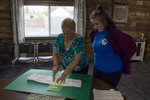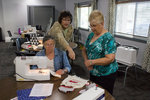

The average American throws away 70 pounds of clothing, shoes and textiles every year. It’s this fact that spurred the Repair What You Wear series, which teaches people how to repurpose old items.
“I think people are thinking that if it’s not in perfect condition, other people won’t want it,” said Melanie Case, who is the recycling program coordinator at Lewis County Department of Public Works Solid Waste Utility. “There are a lot of people out there who are so good at repurposing items — or maybe they want it ripped or looking vintage.”
The Repair What You Wear Series offers free workshops every month where people can learn to repurpose old clothes and items. Case, who runs these workshops, noted that none of the garbage stays in Lewis County because there is no operating landfill.
Case said that many people throw away textiles simply because they don’t know how to repair them. Textiles are one of the most common items people throw away. According to a 2015-2016 Washington Statewide Waste Characterization Study from the State of Washington Department of Ecology, textiles were in the top ten most prevalent material types in the residential disposed waste sector.
“Just in 2017 alone, Lewis County threw away a little over 69,000 tons of garbage,” Case said. “So anything we can do, whether it’s being better about reusing clothing and repurposing, composting your food waste and your yard trimmings, recycling all that you can. It would all add up to reduce that number.”
At the most recent workshop on Thursday night, volunteer Jan Sparks taught participants how to make hanging kitchen towels from old towels and scrap fabric. She and Shawn Hill, another volunteer, are Washington State University/Lewis County master recycler compost volunteers. Sparks knows some of the more technical aspects of sewing and helped designed the workshop series.
Many of the participants at Thursday’s workshop already knew how to sew, but liked learning about new project ideas. Jane Williams, who is now retired, said she enjoys gathering with other people to work on projects.
“I don’t throw away much of anything,” Williams said. “I keep things and I definitely reuse them. I really get a lot of enjoyment when I find something that I’ve saved and I get to reuse it.”
Williams was at the first workshop of the series in April, where participants made a garden tool caddy out of a five-gallon bucket and old jeans. Typically, Williams makes quilts when she sews outside of the workshops.
“I have this American flag quilt that’s up on my wall right now because we’re getting into that season,” WIlliams said. “It just turned out beautiful. I think I went out and bought a lot of fabric, but I am reusing some of the scraps from that. I’m making a banner for a picnic at the end of the month, also. It’s for my mom’s 80th birthday.”
Sarah Moss, a student at Centralia College, also said she knows how to sew but has never made these projects.
“I’ve sewn a lot for my age group,” Moss said. “I made an entire costume once, a couple years ago. I’ve made a few aprons, some basic pillow cases. I understand how sewing machines work. I don’t sew every day of my life, but I have made a few projects.”
Moss previously used her mother’s sewing machine, but had to leave it at home when she moved to Centralia last June.
“My family was very much ‘don’t waste things that can be used,’ especially when it came to sewing,” Moss said. “Because then it would be like ‘man, I just need this little square of red.’ I don’t want to go buy red fabric, but then you go and look in my mom’s giant scrap bin and she’s got like five different patterns of red fabric. It seems silly to throw away things you can use.”
Kathy Porter, another workshop participant, also discussed her dislike of wasting materials.
“I have an area where I keep pieces of old jeans,” Porter said. “Like if the kids would want shorts, I would cut it off and save the bottom parts for when other jeans would wear out and I could take pieces of the jean material. One of my sons just came home to visit a few weeks ago and I actually took some of an old piece and repaired his pants so there wasn’t a big hole.”
Porter said she took a break from sewing for a while, but has decided to spend more time on the craft, because she is expecting her first grandchild this fall.
“I actually went to school and was a home (economics) major years ago, but then I had kids,” Porter said. “I used to sew matching outfits for the kids and cousins and sew shirts. I haven’t sewed much for quite a while. I would do drapes, or hem stuff for the kids, or take it in or do repairs. It was really busy. Now I’m still working, but just part time, and I have time to do it a little bit more. And now with a grandkid on the way, it’s time to do a little bit more sewing.”
Porter said this skill has kept her from wasting materials.
“I think we are in an instant society and some people don’t realize you really can reuse and repurpose a lot more than they think,” Porter said. “I’m guilty of saving too much sometimes, so that can be an issue, too. Saving too much can be an issue, but really a lot of times if you throw it away I’ll even think ‘oh, I could have used that.’”
Porter said friends often refer people to her when their clothes only have minor damages — something that causes some to throw away the whole item.
“I think as Americans, we’re just used to ‘oh, I’ll toss it aside and get another one,’” Porter said. “But I also think that things used to be made better so they lasted longer or you just got them fixed. Sometimes it’s just cheaper to buy a new one than repair something, but if you can sew, then you can do it yourself.”
The Repair What You Wear series workshops take place at various times and dates, but roughly every month at Centralia Community Church of God, located at 3320 Borst Avenue in Centralia. To register for a class, contact Melanie Case at 360-740-1452 or send an email to swu@lewiscountywa.gov.